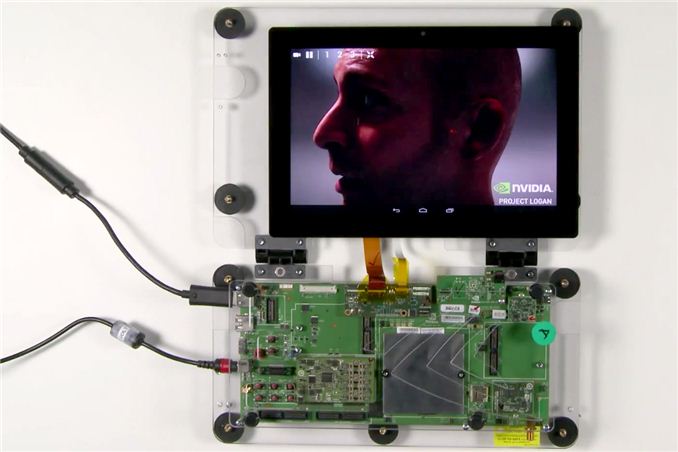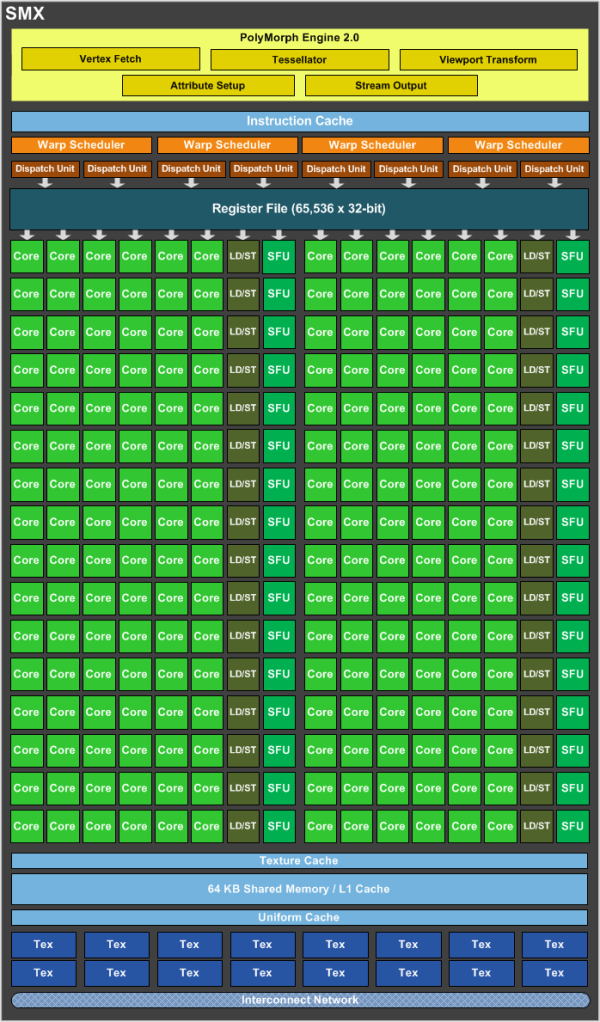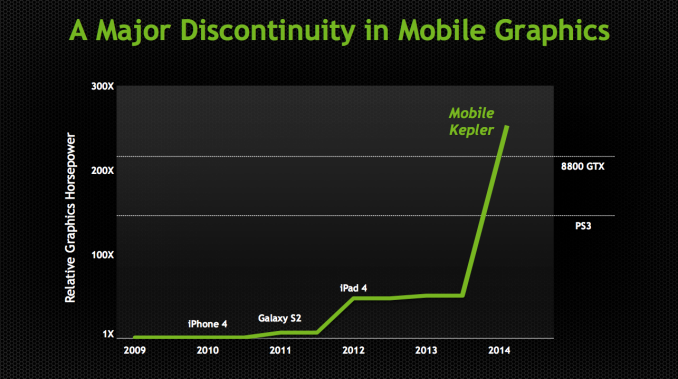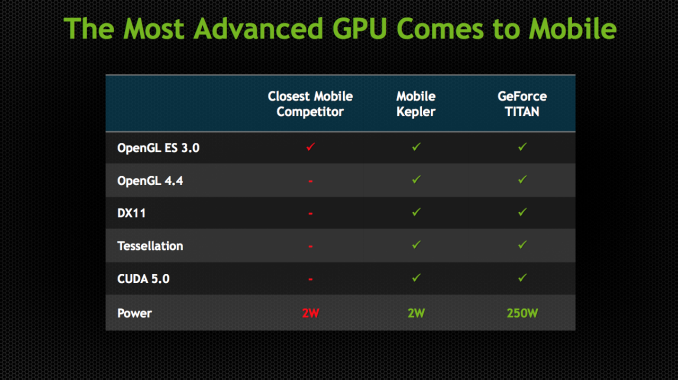NVIDIA Demonstrates Logan SoC: < 1W Kepler, Shipping in 1H 2014, More Energy Efficient than A6X?
by Anand Lal Shimpi on July 24, 2013 9:00 AM EST
Ever since its arrival in the ultra mobile space, NVIDIA hasn't really flexed its GPU muscle. The Tegra GPUs we've seen thus far have been ok at best, and in serious need of improvement at worst. NVIDIA often blamed an immature OEM ecosystem unwilling to pay for the sort of large die SoCs necessary in order to bring a high-performance GPU to market. Thankfully, that's all changing. Earlier this year NVIDIA laid out its mobile SoC roadmap through 2015, including the 2014 release of Project Logan - the first NVIDIA ultra mobile SoC to feature a Kepler GPU. Yesterday in a private event at Siggraph, NVIDIA demonstrated functional Logan silicon for the very first time.
NVIDIA got Logan silicon back from the fabs around 3 weeks ago, making it almost certain that we're dealing with some form of 28nm silicon here and not early 20nm samples.
NVIDIA isn't talking about CPU cores, but it's safe to assume that Logan will be another 4+1 arrangement of cores - likely still based on ARM's Cortex A15 IP (but perhaps a newer revision of the core). On the GPU front, NVIDIA confirmed our earlier speculation that Logan includes a single Kepler SMX:
One Kepler SMX features 192 CUDA cores. NVIDIA isn't talking about shipping GPU frequencies either, but it did provide this chart to put Logan's GPU capabilities into perspective:
Don't get too excited as we're looking at a comparison of GFLOPS and not game performance, but the peak theoretical ALU bound performance of mobile Kepler should exceed that of a Playstation 3 or GeForce 8800 GTX (memory bandwidth is another story however). If we look closely at NVIDIA's chart and compare mobile Kepler to the iPad 4, we get a better idea of what sort of clock speeds NVIDIA would need to attain this level of performance. Doing some quick Photoshop estimation it looks like NVIDIA is claiming mobile Kepler has somewhere around 5.2x the FP power of the PowerVR SGX 554MP4 in the iPad 4 (76.8 GFLOPS). That works out to be right around 400 GFLOPS. With a 192 core implementation of Kepler, you get 2 FLOPS per core or 384 FLOPS per cycle. To hit 400 GFLOPS you'd need to clock the mobile Kepler GPU at roughly 1GHz. That's certainly doable from an architectural standpoint (although we've never seen it done on any low power 28nm process), but it's probably a bit too high for something like a smartphone.
NVIDIA didn't want to talk frequencies but they did tell me that we might see something this fast in some sort of a tablet. I suspect that most implementations will be clocked significantly lower. Even at half the frequency though, we're still talking about roughly Playstation 3 levels of FP power out of a mobile SoC. We know nothing of Logan's memory subsystem, which obviously plays a major role in real world gaming performance but there's no getting around the fact that Logan's Kepler implementation means serious business. For years we've lamented NVIDIA's mobile GPUs, Logan looks like it's finally going to change that.
API Support and Live Demos
Unlike previous Tegra GPUs, Kepler is a fully unified architecture and OpenGL ES 3.0, OpenGL 4.4 and DirectX 11 compliant. The API compliance alone is a huge step forward for NVIDIA. It's also a big one for game developers looking to move more seriously into mobile. Epic's Tim Sweeney even did a blog post for NVIDIA talking about Logan's implementation of Kepler and how it brings feature parity between PCs, next-gen consoles and mobile platforms. NVIDIA responded in kind by running some Unreal Engine 4 demos on Android on a Logan test platform. That's really the big story behind all of this. With Logan, NVIDIA will bring its mobile GPUs up to feature parity with what it's shipping in the PC market. Game developers looking to port games between console, PC, tablet and smartphone should have an easier job of doing that if all platforms supported the same APIs. Logan will take NVIDIA from being very behind in API support (with no OpenGL ES 3.0 support) to the head of the class.
NVIDIA took its Ira demo, originally run on a Titan at GTC 2013, and got it up and running on a Logan development board. Ira did need some work to make the transition to mobile. The skin shaders were simplified, smaller textures are used and the rendering resolution is dropped to 1080p. NVIDIA claims this demo was done in a 2 - 3W power envelope.
The next demo is called Island and was originally shown on a Fermi desktop part. Running on Logan/mobile Kepler, this demo shows OpenGL 4.3 and hardware tessellation working.
The development board does feature a large heatspreader, but that's not too unusual for early silicon just out of bring up. Logan's package size should be comparable to Tegra 4, although the die size will clearly be larger. The dev board is running Android and is connected to a 10.1-inch 1920 x 1200 touchscreen.













141 Comments
View All Comments
ltcommanderdata - Wednesday, July 24, 2013 - link
Even with Keplar's advanced features support, we'll have to see how much effort developers put into optimizing games for Keplar. Most mobile games are developed first for iOS and then ported over to other platforms.http://venturebeat.com/2013/07/23/ea-made-more-sal...
EA just announced that the iOS App Store is EA's biggest retail distribution channel, bigger than other mobile app stores, their own Origin and other PC and console channels. So games being designed for and optimized for iOS/PowerVR GPUs are a given, because that's where the market is. nVidia will have to actively convince mobile developers to support their additional features.
What's more, I don't believe any mobile OS officially supports any version of desktop OpenGL much less OpenGL 4.4. Android 4.3 just announced incorporation of OpenGL ES 3.0. Rather than OpenGL 4.4, the most common implementations will likely have Keplar additional features exposed as a bunch of OpenGL ES 3.0 extensions, which may also limit adoption.
lmcd - Wednesday, July 24, 2013 - link
It isn't like EA is popular with hardcore gamers, so no one truly uses Origin. Their console games mostly suck, their PC games mostly suck.Who is surprised?
Scannall - Thursday, July 25, 2013 - link
I'd just point out that hard core gamers are really a niche market. World wide sales of the Xbox 360 and the PS4 over 8 years is about 70 million each. Not exactly huge.Refuge - Thursday, July 25, 2013 - link
Thank you... Someone who understands!To you good sir... I agree. :)
Kill16by9TN - Friday, July 26, 2013 - link
Johnny's name is KeplEer, not KeplAr!prophet001 - Monday, July 29, 2013 - link
Kepleer hunh.eanazag - Wednesday, July 24, 2013 - link
I am in agreement. Features are just as much a part of the conversation as power and performance. The software side should also be good as Nvidia has done a good job with this. Software/drivers being my biggest gripe for Intel.This is definitely drumming up business for their IP licensing. Squarely aimed at Apple. Intel should take note also because Atom's graphics have always sucked.
So this is big and good news for customers. Thinking smartphone only is too small.
My question is does this do well power-wise for video. We will have to wait and see. I'm glad to see Nvidia hanging around when the idea of a GPU only company hanging around this long was pretty pessimistic. They have been good at redefining themselves, which is very tough for companies. (cough, cough Kodak and HP with Palm)
Refuge - Thursday, July 25, 2013 - link
Their support may be great, but nobody is going to program for Keplar features if they don't hold a solid market share, and I mean VERY solid, mirroring Apple iPhones. I use them as an example because while Androids hold most of the market, they are a mixed back of fragmentation.Also, the new Atoms coming out have almost nothing in common with the old Atoms. People keep making references to the old ones, which I agree were worthless even for a netbook, but the new ones I actually have some high hopes for.
michael2k - Wednesday, July 24, 2013 - link
Correct, I don't think Kepler is all that special. Nvidia has lost a lot of credibility in the mobile space by being unable to take the crown for three years straight. In any case, if you're going to be quoting Kepler PR, this is PowerVR's list of accomplishments for the 6 series GPU:Delivering the best performance in both GFLOPS/mm2 and GFLOPS/mW, PowerVR Series6 GPUs can deliver 20x or more of the performance of current generation GPU cores targeting comparable markets. This is enabled by an architecture that is around 5x more efficient than previous generations. => At the same power level expect 5x the perf, approximately 350GF
All members of the Series6 family support all features of the latest graphics APIs including OpenGL ES 'Halti'*, OpenGL 3.x/4.x, OpenCL 1.x and DirectX10 with certain family members extending their capabilities to full WHQL-compliant DirectX11.1 functionality. => Just like Logan
PowerVR Series6 GPU cores are available for licensing now. => Posted last January! Expect then to see this in SoC this year, not years from now.
lmcd - Wednesday, July 24, 2013 - link
Whaddya mean? Kepler doesn't scale to those either. It only clockspeed scales and is probably close to headroom, while adding another core will make the die WAY too big.No, you're wrong. Also, ES 3.0 is pretty damn close to 4.2 compliance. So don't act like it's a huge jump.
Finally, don't forget AMD's GCN is competing in this space and has proven itself very relevant.